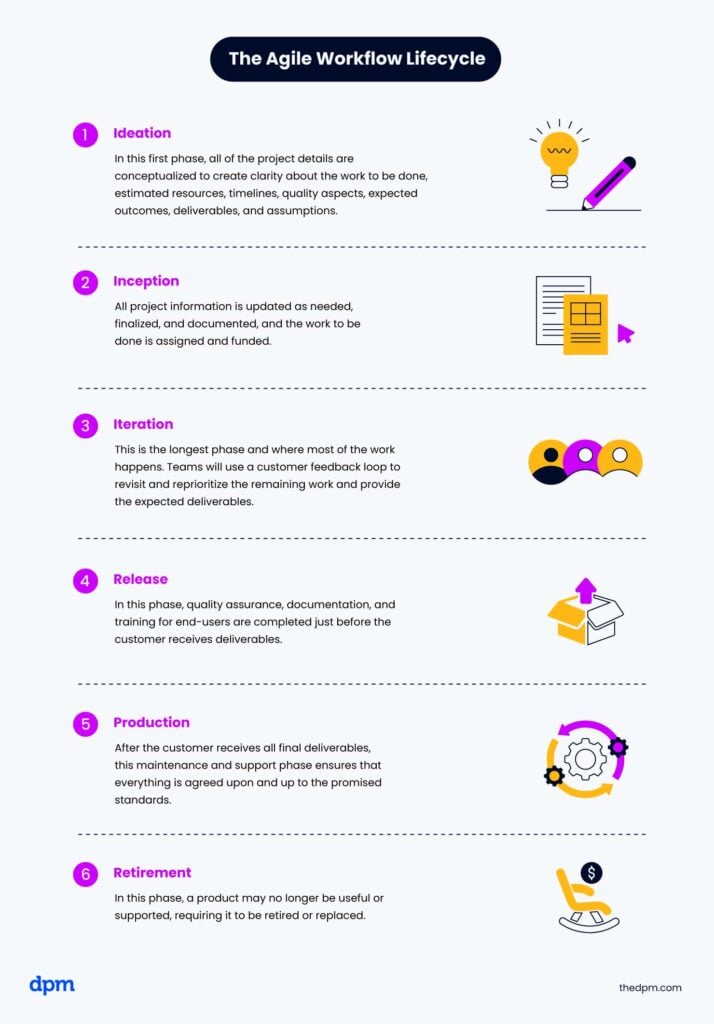Companies that adopt agile workflow processes often outpace their competitors in customer satisfaction, employee engagement, and operational performance.
Creating agile workflows requires careful planning and execution and the right software to efficiently manage tasks, track progress, and facilitate effective communication.
What Is An Agile Workflow?
An agile workflow is a way of working that emphasizes flexibility, continuous improvement, and adaptability.
It allows teams to respond quickly to changing requirements and delivers customer value in shorter cycles. By breaking down work into smaller, manageable pieces called sprints, agile workflow promotes transparency, collaboration, and accountability.
Agile workflows involve an iterative process that differs from traditional working methods, like the waterfall methodology. In agile, the remaining work to be completed at the end of each sprint is revisited and reprioritized based on customer feedback. This provides increased flexibility, faster delivery, and more frequent feedback.
Traditional workflows are more cumbersome and require formal change requests to modify timeframes and reprioritize task completion, which limits efficient delivery.
The Agile Workflow Lifecycle
The agile workflow lifecycle involves these six key phases. Here's a brief overview of each.

- Ideation: In this first phase, all of the project details are conceptualized to create clarity about the work to be done, estimated resources, timelines, quality aspects, expected outcomes, deliverables, and assumptions.
- Inception: All project information is updated as needed, finalized, and documented, and the work to be done is assigned and funded.
- Iteration: This is the longest phase and where most of the work happens. Teams will use a customer feedback loop to revisit and reprioritize the remaining work and provide the expected deliverables.
- Release: In this phase, quality assurance, documentation, and training for end-users are completed just before the customer receives deliverables.
- Production: After the customer receives all final deliverables, this maintenance and support phase ensures that everything is agreed upon and up to the promised standards.
- Retirement: In this phase, a product may no longer be useful or supported, requiring it to be retired or replaced.
How To Create An Agile Workflow
Creating an agile workflow requires careful planning and execution. This step-by-step guide will empower your team and fuel productivity.
1. Define Goals & Gain Buy-in
It starts with clearly defining the goals, objectives, and deliverables to ensure you gain the buy-in needed for your workflow to succeed.
Ensure you understand the business requirements, and identify the desired outcomes. Then, the proposed workflow will be communicated to all stakeholders. This will give stakeholders a clear direction, secure their support, and help align your team's efforts.
2. Establish a Method For Prioritizing The Backlog
You’ll need a system for creating a prioritized backlog, which will list all the tasks or user stories that will need to be completed during a project.
The backlog should be based on the value provided, prioritizing the most critical and high-value items. Collaborate with stakeholders, product owners, and team members when filling up the backlog.
3. Assign Cross-Functional Team Roles
Form cross-functional teams with the necessary skills and expertise to deliver upon their role within the workflow. Project teams should be self-organizing and clearly understand their roles and responsibilities.
4. Hold Regular Meetings
Conduct regular meetings to get feedback on the workflow, keep everyone aligned, and drive continuous improvement. Daily stand-up meetings allow team members to provide updates, discuss any challenges, and ensure everyone is on the same page.
Sprint review meetings and sprint retrospective meetings allow the team to gather feedback, evaluate their performance, and identify areas for improvement.
5. Use Agile Tools and Software
Agile tools and software are crucial in managing workflows and tasks, tracking progress, and facilitating effective communication.
Numerous tools, such as project management tools, task boards, and collaboration or workflow management platforms, are available to help streamline the agile workflow and enhance team collaboration (this is especially important for creative workflows).
6. Embrace Continuous Improvement
Continuous improvement requires regularly evaluating the workflow and the team's performance, identifying areas for improvement, and incorporating feedback into future sprints.
It also means encouraging team members to share their ideas, experiment with new approaches, and embrace change as a catalyst for growth.
I'm a huge fan of embracing a culture of continuous improvement by encouraging feedback, learning from experiences, and adapting business processes. I first heard about it in 1990 and have believed in it ever since.
Key Team Roles in an Agile Workflow
Agile workflows involve specific roles that contribute to the success of the project. Let's explore some of the key roles in an agile team.
- Product owner: They are responsible for defining and prioritizing the product backlog, which is the list of features, enhancements, and bug fixes. They work closely with stakeholders and users to gather requirements, clarify expectations, and ensure that the product meets customer needs. They act as the voice of the customer and are responsible for maximizing the value delivered by the team.
- Scrum master: The Scrum master is the team's facilitator and servant leader. They ensure that the Scrum framework is followed, remove any obstacles that hinder progress, and protect the team from external distractions. The Scrum master also facilitates sprint planning, daily stand-ups, and retrospectives, and promotes a culture of continuous improvement and collaboration within the team.
- Agile development team: The team consists of individuals who carry out the work. They are responsible for self-organizing and collaborating to complete the tasks that were committed to during sprint planning. The product development team members may have different specialties or areas of expertise, but they share the responsibility of delivering a high-quality product at the end of each sprint.
- Other roles: There are also others involved in agile workflow, including stakeholders, testers, designers, developers, and end users.
Types of Agile Workflows
Agile methodologies are versatile and can be tailored to suit different teams and projects' specific needs and requirements. The many agile frameworks share the common principles of adaptability, collaboration, and continuous improvement.
- Scrum: Scrum is one of the most widely used agile frameworks, particularly in software development, and spells out defined roles, ceremonies, and artifacts. Work is done during time-boxed iterations called sprints, which usually last 1-4 weeks. Each sprint begins with a planning session where the team selects what to work on. Daily stand-up Scrum meetings, reviews, and retrospectives are held at various points during the sprint.
- Kanban: Kanban is a visual agile method that promotes a continuous flow of work. It uses a Kanban board to visualize tasks and their progress across different stages, typically represented by columns. The workflow limits work in progress (WIP) to prevent bottlenecks and maintain flow. As tasks are completed, new ones are pulled from the backlog.
- Lean: Inspired by lean manufacturing principles, lean focuses on minimizing waste and maximizing value. It emphasizes the importance of continuous improvement and eliminating non-value-adding activities. Lean agile workflows often incorporate practices that involve identifying areas of inefficiency or waste.
- Feature-driven development (FDD): FDD focuses on formulating advanced features and scope, aiming to develop and implement the entire model. It's a customer-focused, incremental method aimed at delivering frequent, tangible outcomes. With FDD, teams can quickly isolate errors and make adjustments without delays.
- Extreme programming (EX): EX is built on values and principles and is based on customer feedback as the primary source for making technical software changes. The goal is high-quality deliverables, which are determined by customer satisfaction.
Other agile workflows include Dynamic Systems Development Method (DSDM), Crystal, and Adaptive Project Framework (ADF).
Benefits of Agile Workflows
- Increased flexibility and adaptability: Traditional project management methods often struggle to accommodate unexpected changes, leading to delays and frustrations. Conversely, agile embraces change, encourages teams to reassess priorities, and regularly adapt their approach.
- Higher value deliverables and shorter cycles: Agile project management allows teams to release working software or products incrementally instead of waiting for months to see tangible results. This helps gather early feedback from customers and enables teams to make course corrections along the way, ensuring that the end product meets the desired outcomes.
- Improved team collaboration and transparency: By breaking down work into sprints, team members have better visibility into each other's tasks and progress. Daily stand-up meetings, where team members share their accomplishments, plans, and any roadblocks, foster open communication and enable quick problem-solving to identify bottlenecks in the current and next sprint.
- Increased customer satisfaction, employee engagement, and operational performance: Testing and customer feedback are built into project execution, which helps sprint teams learn as they go through each iteration. This improves the overall quality of the final deliverables and has increased customer satisfaction in 93% of companies using agile. It also improved employee engagement in 76% of those companies and operational performance by 93%.
- High levels of predictability: The agile approach increases visibility throughout each cycle. When teams can get a clearer roadmap much sooner, it makes it easier to decrease risks, meet specifications, and deliver on time.
Tips For Creating Agile Workflows
Effectively implementing agile workflows requires careful planning and execution. Here are some practical tips to help you create successful agile workflows:
- Define clear goals and objectives: Before diving into agile, clearly define your goals and objectives. Identify the problem you are trying to solve, the desired outcomes, and the metrics you will use to measure success. This clarity will guide your agile implementation and ensure that your workflows align with your overall objectives.
- Involve stakeholders and users: Agile workflows thrive on regular feedback and collaboration with stakeholders and users. Involve them in the process right from the beginning and throughout the project. By incorporating their perspectives and requirements, you can ensure that your workflows prioritize customer value and address their needs effectively.
- Start small and iterate: When implementing agile workflows, start with a small pilot project or team. This way, you can learn and adapt without having to involve the entire organization in the messiness that occurs at the beginning of this process. Gather feedback, identify areas for improvement, and iterate on your workflows based on the lessons learned. This iterative approach will help you refine your development processes and ensure continuous improvement.
- Invest in training and support: Agile workflows require a mindset shift and may require new skills and knowledge. Invest in training and support for your team members to ensure they understand the agile principles and practices. Provide coaching and mentorship to help them embrace the agile mindset and apply it effectively in their work.
- Embrace collaboration and communication tools: Agile workflows rely heavily on collaboration and communication. Invest in workflow management tools that facilitate effective collaboration, such as project management software, chat platforms, and video conferencing tools. These tools will enable your team to stay connected, share progress, and collaborate seamlessly, regardless of their location.
- Continuously Evaluate and Adapt: Agile is all about continuous improvement. Regularly evaluate your workflows, gather feedback from your team, and adapt them based on the insights gained. Embrace a culture of learning and experimentation, and encourage your team members to share their ideas for improving the workflow. You can optimize your agile workflows for maximum productivity and success by continuously evaluating and adapting.
By embracing the principles of flexibility, collaboration, and continuous improvement, combined with robust workflow automation, agile empowers teams to adapt quickly, deliver high-quality results, and exceed customer expectations.
Join For More Project Workflow Insights
Want to connect with other digital project managers to share resources and best practices? Join our membership community and get access to 100+ templates, samples, and examples and connect with 100s of other digital project managers in Slack.


